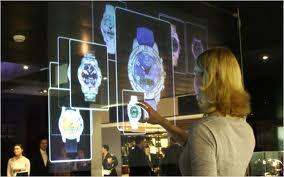Rendering tactile effects on a touch screen via electrovibration has many potential applications. However, our knowledge on tactile perception of change in friction and the underlying contact mechanics are both very limited. In this study, we investigate the tactile perception and the contact mechanics for a step change in friction under electrovibration during a relative sliding between finger and the surface of a capacitive touchscreen. First, we conduct magnitude estimation experiments to investigate the role of normal force and sliding velocity on the perceived tactile intensity for a step increase and decrease in friction, called as rising friction (RF) and falling friction (FF). To investigate the contact mechanics involved in RF and FF, we then measure the frictional force, the apparent contact area, and the strains acting on the fingerpad during sliding at a constant velocity under three different normal loads using a custom-made experimental set-up. The results show that the participants perceived RF stronger than FF, and both the normal force and sliding velocity significantly influenced their perception. These results are supported by our mechanical measurements; the relative change in friction, the apparent contact area, and the strain in the sliding direction were all higher for RF than those for FF, especially for low normal forces. Taken together, our results suggest that different contact mechanics take place during RF and FF due to the viscoelastic behavior of fingerpad skin, and those differences influence our tactile perception of a step change in friction.
翻译:通过电动振动对触摸屏幕产生的触摸效应有许多潜在应用。然而,我们对摩擦变化和基本接触力力变化的触觉感知知识都非常有限。在本研究中,我们调查触觉感知和接触力,以便在手指与触动力屏幕表面相对滑动期间电动下摩擦的逐步变化。首先,我们进行量度估计实验,以调查正常力和滑动速度对感觉触感触感强度的作用,以逐步增加和减少摩擦,称为摩擦和摩擦的上升。为了调查RF和FF的接触力,我们随后测量摩擦力、明显的接触力和接触力,以及在三次不同正常负荷下以恒定速度滑动时,使用定制的实验设置。结果显示,与会者认为RF比FF更强,正常力和滑动速度都大大影响他们的认知力。这些结果得到我们的机械测量的支持;摩擦和摩擦的相对行为力变化,明显的接触力区域,以及我们正常接触力的相对变化,特别是常规接触力,所有接触力的推移动力。




